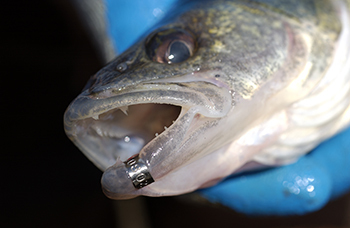|
Oct. 10, 2024
Contact: Jay Wesley, 269-204-7057 or Jeremiah Blaauw, 906-235-7679
Anglers who report marked and tagged fish provide DNR with critical information
There are many joys of fall fishing: the salmon run, cooler weather and gorgeous fall foliage. Another benefit is the opportunity to help with important fisheries research by telling the Michigan Department of Natural Resources about any tagged or marked fish you catch.
“Marking and tagging fish helps DNR researchers understand fish survival, age, growth and movement, as well as the amount of natural reproduction of a species,” said Jay Wesley, the DNR’s Lake Michigan basin coordinator.

Through mass marking assistance by the U.S. Fish and Wildlife Service, Great Lakes states mark popular gamefish like steelhead, Chinook salmon, Atlantic salmon, brown trout and lake trout. These marks include both clipped adipose fins and coded-wire tags.
The DNR has used a coded-wire tag program to mass mark various fish species in Michigan since the 1980s. The program involves implanting a small, coded-wire tag, which is invisible to the naked eye, into the snout of a fish. The tag is small — like the tip of a lead pencil — so lab technicians are needed to remove it.
Trout and salmon containing a coded-wire tag can be identified because their adipose fins (the small, fleshy fin between the dorsal and tail fins) have been removed. The DNR asks that anglers who catch a fish with a clipped adipose fin remove and freeze the head of the fish and turn it in at a local drop-off station in Michigan.
|

Anglers may also come across other fish tags or markings including:
- Telemetry or temperature depth-recording tags, some of which may only be discovered when cleaning a fish.
- Jaw tags, which are metal bands attached to a fish’s upper or lower jaw.
- Anchor tags, which are often inserted near the base of a fin.
- Fin clips (total or partial removal of fins) on fins other than the adipose fin.
Report marked fish through the DNR’s Eyes in the Field app to provide information such as species, tag details, photos, and date and location caught, or by contacting a local DNR fisheries office. Some tags can be reused, and some tags offer small monetary rewards for reporting them.
Learn more about marked and tagged fish.
|
Note to editors: An accompanying photo is available below for download. Caption information follows.
-
Jaw tag: Anglers may catch fish with jaw tags, which are metal bands attached to a fish’s upper or lower jaw.
|